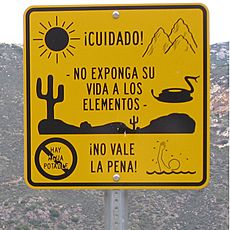Migrant deaths along the Mexico–United States border facts for kids
United States border with Mexico is one of the world's "most lethal land borders". Hundreds of migrants die per year as they attempt to cross into the United States from Mexico illegally. The US Border Patrol reported 294 migrant deaths in the fiscal year 2017 (ending September 30, 2017), which was lower than in 2016 (322), and any year during the period 2003–2014. Exposure (including heat stroke, dehydration, and hyperthermia) were the leading cause.
The group Border Angels estimates that since 1994, about 10,000 people have died in their attempt to cross border. According to the U.S. Customs and Border Protection, 7,216 people have died crossing the U.S–Mexico border between 1998 and 2017. In 2005, more than 500 died across the entire U.S.–Mexico border. The number of yearly border crossing deaths doubled from 1995 to 2005, before declining. The statistics reflect only known deaths and do not include estimates for those who have never been found. Some migrant deaths may go unreported even when they are brought to the attention of officials.
Mexico's Secretariat of Foreign Affairs has compiled data including deaths on the Mexican side of the border area during the period from 1994 to 2000. The data shows 87 deaths in 1996, 149 in 1997, 329 in 1998, 358 in 1999, and 499 in 2000.
U.S. Border Patrol reported that 3,221 migrants were rescued in the fiscal year 2017.
Impact on border communities
The impact of migrant deaths on border communities can be difficult for small towns on the U.S. side, which have found themselves with hundreds of remains to identify and bury, at a cost of hundreds of thousands of dollars. In November 2013, the Office of the Medical Examiner in Pima County, Arizona, had 871 cases of unidentified remains dating as far back as the 1990s. Relief groups often aid migrants traveling along the border. A Mexican federal task force known as Grupos Betas protects migrants from crime while the migrants make the journey north. Other groups such as 'No More Deaths' provide migrants with humanitarian assistance and members participate in 'desert runs' to search for migrants in need of help.
International consequences
The deaths have caused tension between the United States and other countries, particularly Mexico and the countries of Central America, from where a majority of illegal immigrants who enter the United States through the Southwestern borders come. Foreign consulates across the Southwest United States, in particular those of Latin American countries, have condemned the deaths of illegal immigrants across the border.


